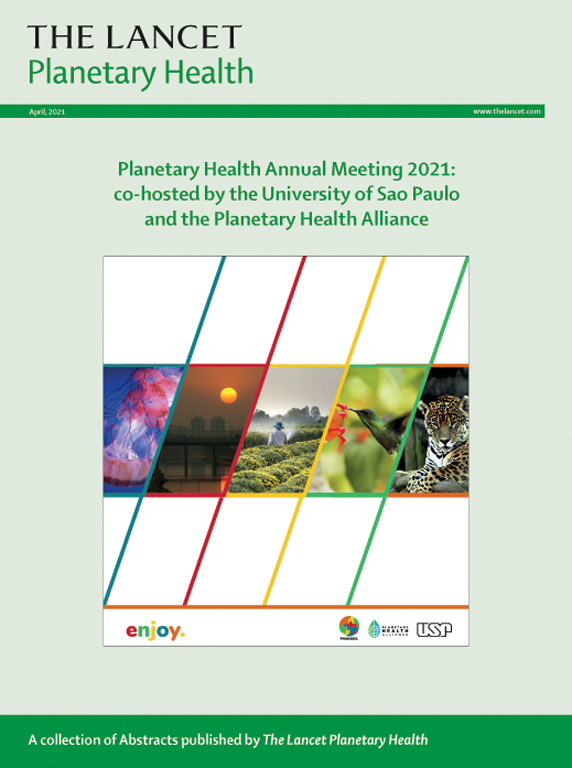Effects of city design on transport mode choice and exposure to health risks during and after a crisis: a retrospective observational analysis
IF 21.6
1区 医学
Q1 ENVIRONMENTAL SCIENCES
引用次数: 0
Abstract
Background
Rapid declines in city mobility during the early stages of the COVID-19 pandemic in 2020 resulted in reductions in citizens’ exposure to transport-related air pollution and associated health risks as many cities introduced non-pharmaceutical interventions designed to curb the spread of COVID-19. However, these benefits soon reversed during the pandemic's recovery phase (ie, from September, 2020, onwards), especially in cities with designs that afforded mode shifts away from public and active transport in favour of private motor vehicles. The aim of this study was to understand the association between global city designs, transport mode choices, and population-level risk exposure during 2020.
Methods
In this retrospective observational analysis, we assembled and analysed spatial datasets (including historical and predicted pollution levels, mobility indicators, and measures of individual disease transmission) and clustered 507 global cities using a graph neural network approach based on measures of the structural dimensions of each individual city's design and network structures of urban transportation systems. We compared city types on the basis of transportation mode shifts, air pollution levels, and associated health outcomes (ie, cardiovascular disease, ischaemic heart disease, respiratory disease, asthma, and reported COVID-19 cases) throughout 2020. We estimated risk reductions for these health outcomes across four phases of the pandemic, which we defined as the pre-pandemic, entry, mid-crisis, and recovery phases. We also identified city designs showing sustained reductions at the end of 2020 in transport-related air pollution (fine particulate matter [PM2·5] and nitrogen dioxide [NO2]) associated with reduced estimated risk of acute and chronic disease outcomes (ie, all-cause mortality, ischaemic heart disease mortality, cardiovascular disease, respiratory disease, and asthma).
Findings
The mean estimated reduction of global NO2 concentrations across the observed cities from the beginning of the entry phase until the mid-crisis phase was 3·76 parts per billion (ppb), calculated as the difference between observed 2020 mean levels of 12·63 ppb and predicted mean levels (if the pandemic and mobility restrictions had not occurred) of 16·39 ppb. The mean estimated reduction of global PM2·5 concentrations across the observed cities was 9·76 μg/m3 (the difference between observed 2020 mean levels [29·03 μg/m3] and predicted mean levels [38·79 μg/m3]). If maintained over the long term, the estimated NO2 reduction could have a substantial effect on reducing health risks for both acute and chronic disease, equating to an estimated overall reduction in all-cause mortality risk of 1·5% (95% CI 2·2–3·0), a reduction in cardiovascular mortality risk of 4·1% (2·6–6·0), and a reduction in respiratory disease mortality risk of 1·9% (0·8–3·0). If the reduction in PM2·5 concentration estimated in this period was maintained over the long term, all-cause mortality risk reductions of 18·9% (95% CI 13·2–25·0), asthma risk reductions of 46·8% (18·7–65·5), and ischaemic heart disease morbidity risk reductions of 0·25% (0·2–0·3) could be achieved. In the later stages of 2020, city designs (primarily in the Americas and Oceania) that afforded a mode shift away from public transit to private motor vehicles during the pandemic's recovery phase tended to show the poorest outcomes across all air pollution and health measures, even increasing risk levels above pre-pandemic baselines in some cases. By contrast, cities located in Japan and South Korea showed little change in pre-crisis and post-crisis transport mode choice, maintaining comparatively low levels of air pollution and associated disease risk, and reduced rates of infectious disease transmission throughout the 2020 observation period. Contrasting experiences of road injury in the post-pandemic phase (ie, post 2020) were also observed between these locations.
Interpretation
Our results highlight the transient environmental and health benefits observed during the early stages of the COVID-19 pandemic, driven by substantial reductions in transport-related air pollution and associated health risks due to imposed non-pharmaceutical public health interventions. City design appears to have played a crucial role in observed pollution and health risk differences between cities, with those that afforded a shift away from public and active transport towards private vehicles witnessing a rapid erosion of pollution-related health benefits gained in the entry to mid-crisis phases of the pandemic. These negative effects appear to have also transferred through to increased rates of road trauma in these cities, with a resurgence in road injury above pre-pandemic levels, particularly within countries reliant on private motorised transport. Conversely, cities in Japan, South Korea, and some European regions, which did not experience modal shifts towards cars, sustained their reductions in air pollution and have continued along a trend of declining road transport injuries. These findings underscore city design as a key factor in navigating pandemic-related challenges and suggest that city designs with higher levels of public and mass transit show greater levels of resilience when confronted with infectious disease threats.
Funding
Australian National Health and Medical Research Council, Australian Research Council, National Institute for Health and Care Research Global Health Research Centre for Non-Communicable Diseases and Environmental Change, UK Prevention Research Partnership, and Economic and Social Research Council.
城市设计对交通方式选择和危机期间及危机后健康风险暴露的影响:回顾性观察分析
背景2020年2019冠状病毒病大流行初期,由于许多城市采取了旨在遏制2019冠状病毒病传播的非药物干预措施,城市流动性迅速下降,导致市民接触交通相关空气污染和相关健康风险的机会减少。然而,在大流行的恢复阶段(即从2020年9月起),这些好处很快就被逆转了,特别是在设计上允许从公共和主动交通方式转向私人机动车辆的城市。本研究的目的是了解2020年全球城市设计、交通方式选择和人口水平风险暴露之间的关系。方法在回顾性观察分析中,我们收集并分析了空间数据集(包括历史和预测的污染水平、流动性指标和个体疾病传播措施),并使用基于每个城市设计的结构维度和城市交通系统网络结构的图神经网络方法对507个全球城市进行了聚类。我们根据2020年全年的交通方式转变、空气污染水平和相关健康结果(即心血管疾病、缺血性心脏病、呼吸系统疾病、哮喘和报告的COVID-19病例)对城市类型进行了比较。我们在大流行的四个阶段对这些健康结果的风险降低进行了估计,我们将其定义为大流行前、进入、危机中期和恢复阶段。我们还发现,城市设计显示,到2020年底,与交通相关的空气污染(细颗粒物[PM2·5]和二氧化氮[NO2])持续减少,这与急性和慢性疾病结局(即全因死亡率、缺血性心脏病死亡率、心血管疾病、呼吸系统疾病和哮喘)的估计风险降低有关。从进入阶段开始到危机中期,观测到的城市全球二氧化氮浓度的平均估计降幅为3.76亿ppb,计算方法是根据观测到的2020年平均水平12.63 ppb与预测平均水平(如果没有发生大流行和流动限制)16.39 ppb之间的差异计算。观测城市全球PM2·5浓度的平均估计降幅为9.76 μg/m3(2020年观测平均值[29.03 μg/m3]与预测平均值[38.79 μg/m3]之差)。如果长期维持,估计的二氧化氮减少可能对降低急性和慢性疾病的健康风险产生实质性影响,相当于估计全因死亡风险总体降低1.5% (95% CI 2·3·0),心血管死亡风险降低4.1%(2·6-6·0),呼吸道疾病死亡风险降低1.9%(0·8-3·0)。如果在此期间估计的PM2·5浓度的降低能够长期维持,则可以实现全因死亡风险降低18.9% (95% CI 13.2 - 25.0),哮喘风险降低46.8%(18.7 - 65.5),缺血性心脏病发病率风险降低0.25%(0.2 - 0.3)。在2020年后期,在大流行的恢复阶段,城市设计(主要是在美洲和大洋洲)提供了从公共交通到私人机动车辆的模式转变,在所有空气污染和健康措施中往往显示出最糟糕的结果,在某些情况下甚至使风险水平高于大流行前的基线。相比之下,日本和韩国的城市在危机前和危机后的交通方式选择上几乎没有变化,在2020年的整个观察期内,空气污染和相关疾病风险保持在相对较低的水平,传染病传播率也有所下降。还观察到这些地区在大流行后阶段(即2020年后)的道路伤害经历存在差异。我们的研究结果强调了在COVID-19大流行的早期阶段观察到的短暂的环境和健康效益,这是由交通相关的空气污染和强制实施的非药物公共卫生干预措施导致的相关健康风险大幅减少所推动的。城市设计似乎在观察到的城市之间的污染和健康风险差异中发挥了至关重要的作用,那些从公共和主动交通工具转向私人交通工具的城市,在大流行危机进入到中期阶段期间获得的与污染有关的健康效益迅速受到侵蚀。这些负面影响似乎还导致这些城市的道路创伤率上升,道路伤害再次高于大流行前的水平,特别是在依赖私人机动交通的国家。 相反,日本、韩国和一些欧洲地区的城市没有经历交通方式向汽车的转变,它们的空气污染持续减少,道路交通伤害也继续呈下降趋势。这些发现强调了城市设计是应对大流行相关挑战的关键因素,并表明,在面对传染病威胁时,公共和公共交通水平较高的城市设计表现出更强的弹性。资助:澳大利亚国家卫生和医学研究理事会、澳大利亚研究理事会、国家卫生和保健研究所、非传染性疾病和环境变化全球卫生研究中心、联合王国预防研究伙伴关系以及经济和社会研究理事会。
本文章由计算机程序翻译,如有差异,请以英文原文为准。
求助全文
约1分钟内获得全文
求助全文
来源期刊

Lancet Planetary Health
Multiple-
CiteScore
28.40
自引率
2.30%
发文量
272
审稿时长
8 weeks
期刊介绍:
The Lancet Planetary Health is a gold Open Access journal dedicated to investigating and addressing the multifaceted determinants of healthy human civilizations and their impact on natural systems. Positioned as a key player in sustainable development, the journal covers a broad, interdisciplinary scope, encompassing areas such as poverty, nutrition, gender equity, water and sanitation, energy, economic growth, industrialization, inequality, urbanization, human consumption and production, climate change, ocean health, land use, peace, and justice.
With a commitment to publishing high-quality research, comment, and correspondence, it aims to be the leading journal for sustainable development in the face of unprecedented dangers and threats.
 求助内容:
求助内容: 应助结果提醒方式:
应助结果提醒方式:


